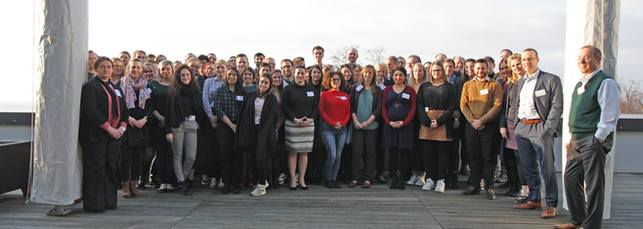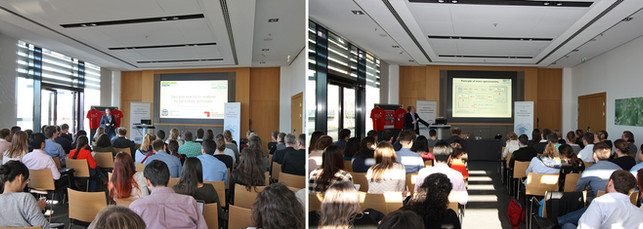
Dr. Heidi Noels and Dr. Yvonne Döring receive the W.H. Hauss Award from the DGAF
19-21 April 2018
Dr. Heidi Noels from the Institute for Molecular Cardiovascular Research at RWTH Aachen University together with Dr. Yvonne Döring from the Institute for Prophylaxis and Epidemiology of Circulatory Diseases at LMU Munich together received the DGAF W.H. Hauss Award 2018 from the German Society for Atherosclerosis Research (DGAF) during the 32nd Annual Meeting of the DGAF in Rauischholzhausen, Germany. They were awarded for their publication "Vascular CXCR4 Limits Atherosclerosis by Maintaining Arterial Integrity: Evidence From Mouse and Human Studies." (Circulation. 2017; 136: 388-403). In this work it could be shown that vascular CXCR4 has an atheroprotective function by maintaining the arterial integrity and preserving the endothelial barrier function. In addition, CXCR4 stabilizes a contractile smooth muscle cell phenotype. Targeted enhancement of these CXCR4-mediated protective functions could open up novel therapeutic options in the treatment of atherosclerosis.
The award was sponsored by a long-standing active member of the DGAF, Prof. Dr. Winfried März.
Project area Z
Administrative project
Robert Werner Mertens
MD student
University Hospital RWTH Aachen
Department of Internal Medicine
Project: The role of incretin hormone GLP-2 in septic cardiomyopathy
PI: Michael Lehrke
Robert Werner Mertens
MD student
University Hospital RWTH Aachen
Department of Internal Medicine
Project: The role of incretin hormone GLP-2 in septic cardiomyopathy
PI: Michael Lehrke
Consortium


Mechanisms of Cardiovascular Complications
in Chronic Kidney Disease
The SFB/TRR219 is supported by the German Research Foundation (DFG)
Project-ID 322900939
Fair Principles (#7)
This letter guides readers through the essential aspects of implementing the FAIR principles to ensure research data is Findable, Accessible, Interoperable, and Reusable. It covers practical steps for making data FAIR, the distinction between FAIR and open data, and highlights tools and platforms like Zenodo and Coscine that facilitate this process.

Introduction
Scientific integrity forms the foundation of trustworthy science. Researchers bear a significant responsibility to adhere to good scientific practice and the FAIR principles, as outlined in the Higher Education Act of NRW. These principles impose high-level requirements on both research data and descriptive metadata, to ensure that data can be found and meaningfully interpreted by other researchers.
FAIR stands for Findable, Accessible, Interoperable, and Reusable. Implementing these principles can be challenging, so let's discuss how to do it in practice.
Distinction between FAIR Data and Open Data
Open Data is accessible to everyone on the Internet. FAIR Data, however, does not necessarily need to be open to be public. Data can be findable and have clearly defined accessibility criteria without being freely available to everyone. Sensitive or personal information can be shared selectively with authorized researchers.
Thus, while FAIR is not the same as open, open data is often easier to make FAIR.
How to make your data FAIR
1) The easies way is to make your data FAIR is to make it openly available online, preferably on dedicated data platforms. These platforms, such as Zenodo or the Open Science Framework cater to various research communities and help you meet FAIR requirements by prompting you to provide the necessary information.
If you cannot make your data openly available, you can still make the metadata available on such platforms. This is an important step towards making your data FAIR.
Zenodo, for instance, creates a DOI (Digital Object Identifier) for your data, providing a unique identifier that helps others find and cite your data over a long time.
2) Make your data known. Besides deposing your data or metadata in an online repository, it's crucial to publicize it. Share information about your data within your community and on social media to ensure that others know about its existence and potential usefulness.
Understanding the FAIR Principles
F for Findable
To make your data findable, focus on two key steps:
1) Attach a DOI to your data. Many data platforms, like Zenodo make that really easy for you.
2) Provide rich, machine-readable metadata. If you upload your data to a good data platform, the most relevant metadata will be asked from you anyhow. Platforms like Coscine help collect metadata at various levels, ensuring comprehensive information about your data.
A for Accessible
FAIR is not synonymous with open. The focus of "Accessible" is to clearly state the conditions for accessing the data. Explain how others can gain access, whether througt direct availability on a platform or via an application process evaluated by a data-use-and-access committee.
I for Interoperable
To make your data interoperable:
1) Use common data formats (e.g., .csv for tabular data, .jpeg for images) as defined by your community standards.
2) Use understandable terms and provide definitions where necessary. Create a codebook for abbreviations and terms.
3) Provide context by linking your data with related datasets or publications and adding metadata to public knowledge graphs like Wikidata.
R for Reusable
To enchance the reusability for your data:
1) Include rich, machine-readable metadata according to your community standards.
2) Attach a clear license, such as the Creative Commons CC-BY, specifying how others can use your data (we talked more about licenses in the previous Newsletter).
Conclusion
FAIR is not a binary concept. While perfect compliance with the FAIR principles is not achievable, every step towards making your data more FAIR is valuable. The goal is continuous improvement.

Disclaimer
I hope this was an interesting read. If you have comments, remarks, or suggestions about other RDM-related topics for the next newsletters, please let me know by sending me an email at dukkart@itc.rwth-aachen.de.
Image designed by FOSTER Open Science











